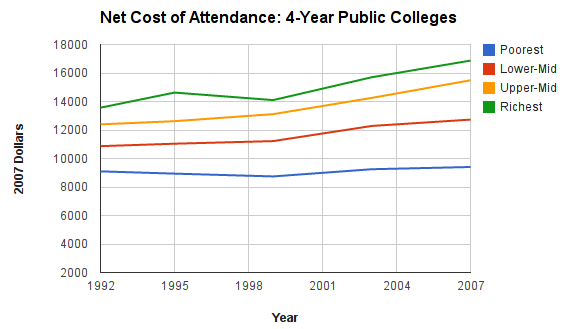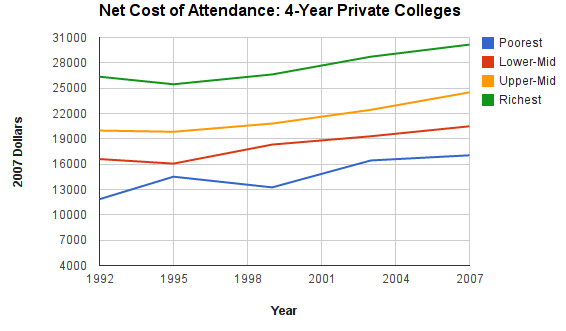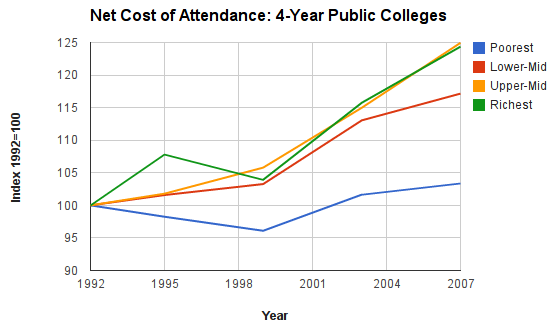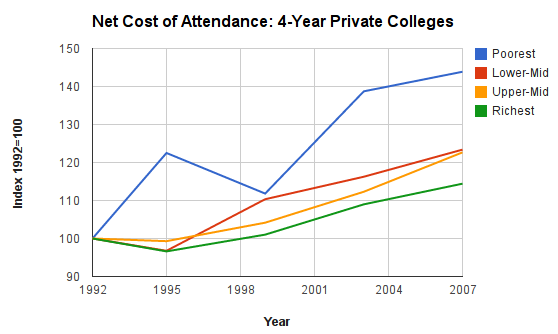Evan Soltas has a good piece in Bloomberg on the popular misconception that college costs are soaring. The problem he addresses is that the headline number for the price of college is not actually what students pay. Colleges use price discrimination which means that they charge students from wealthier families more than those from poorer families. Instead of doing so explicitly by quoting different prices, they charge the same price and then effectively reduce the price based on household income via grants. So the more accurate way to measure the cost of college is not by the published tuition, but by the net tuition.
When you do that, as Soltas shows, prices certainly have risen over the past 20 years, but not nearly as much as people imagine. The published tuition and fees for college have risen around 225%, but the net tuition and fees have risen around 50% or less. That is still a substantial increase, but it hardly counts as the sort of emergency certain commentators suggest. The data set Soltas uses for his figures comes from the College Board, which has net costs broken down by household income as well. Soltas talks briefly about the distributive breakdown, but I would like to delve deeper.
The following are graphs of the cost of college attendance (tuition and fees plus room and board minus grants) for four-year colleges broken down by household quartile.


Here are the same graphs, but this time I index the cost of attendance for each quartile to 100 at 1992. This graph allows you to see by what percent students from each quartile’s cost of attending college has grown since 1992.


The cost of attending a four-year public university for students from the poorest fourth of households has only increased by 3.4% since 1992. Students from the same households, but who attend private universities, have seen their total cost of attendance rise by a considerably higher 43.9%. In private schools, the cost of attendance for the richest half of students has grown the least, while the opposite is true for public schools.
In absolute numbers, it is still the case that the cost of attending college is a sliding scale based on income. In public schools, the poorest students pay just 55.7% of what rich students pay. In private schools, the poorest students pay 56.5% of what rich students pay.
The takeaways from this data are many. First, it is always important to get clarity on what individuals are talking about when they say college costs. The sticker price is way different from net cost, and net cost is also way different from what any given individual will pay. The sticker price is a broadly useless statistic; the net cost is best for determining the overall increase in college costs; and, the net cost of attendance broken down by income is best for figuring out what individual students will pay based on their household background. These distinctions are almost never made anywhere, certainly not in the popular media or by campaigns and organizations that focus on student issues.
Second, I think it scores another blow against the strange desire to put college student issues under the heading of class issues. Colleges are disproportionately made up of rich students. Poor students pay well under the price people imagine that they pay, and haven’t seen their cost of attendance grow in public schools for 20 years. Graduates with the highest incomes have the highest debts, while those with the lowest incomes have the lowest debts. And finally, there is as always the issue of the college wage premium which awards college graduates $1 million over the course of their lifetime, making claims that they are victims of class oppression rather suspect.
I have said this often, but I really think this student issue leftism stuff is barking up the wrong tree. Students are coalition members of the left and if throwing their issues in is important for vulgar coalition-building purposes, then so be it. But if anyone truly thinks there are deep class issues involved here, I do not see how they come to that conclusion. The serious harm visited upon poor students is contained in those 19 years before college rolls around, during which time they are forced by our distributive institutions to contend with the conditions of poverty while trying to get a basic education. Putting college student issues as the focal point — or as any point — of our class justice education agenda is bizarre to say the least.